Executive Summary
Financial advisors will sometimes talk about ‘bad’ clients who don’t act on the advice being provided. But the reality is that they may not necessarily be ‘bad’ clients; rather, their behaviors are a sign that they are not fully engaged in the planning process because other aspects of their life take precedence over managing the tasks needed to accomplish their financial planning goals, they lack the knowledge to make an informed decision, or they are procrastinating for any number of reasons. But by focusing on advice engagement strategies and encouraging clients to become more engaged in the planning process, advisors can help clients become more motivated to take action, which will ultimately serve to improve their planning outcomes.
Advice Engagement is a framework that can help advisors address the challenge of motivating clients. As an emerging concept, Advice Engagement is designed to improve the delivery of advice and encourage clients to become more active in the financial planning process, with the ultimate goal of improving the likelihood that the client will accept and follow the advice.
Client engagement in the financial planning process is not a clear-cut binary characteristic; rather, it can fall onto a dynamic spectrum of engagement levels. While understanding the variability of clients can help to uncover who the advisor’s disengaged clients may be, it can also help advisors identify the root causes of the disengagement so that they can take the right approach to address the disengagement. For instance, clients will show different levels of ‘capability variability’, or the range of financial acumen they bring to the table. While less capable clients will likely show little interest in financial planning concepts and can be encouraged to engage in the process through educational content that helps them better understand the potential outcomes of their plans, a more highly capable client might question or even challenge the advisor’s recommendations. For this client, a general outline of their plan’s intended outcomes may not be as engaging as hypothetical illustrations and a stimulating debate about the efficacy of their plan’s detailed mechanics.
To help clients advance to higher levels on the engagement spectrum, advisors can apply Advice Engagement strategies to 4 key areas: fact finding (e.g., by breaking the data-gathering process into stages to collect information incrementally); advice delivery (e.g., by ensuring that clients receive information in a way that is useful for them); education (e.g., by keeping a variety of materials on hand that advisors can use to educate clients with different learning styles); and ongoing service (e.g., by using client portals or email throughout the year to keep clients focused on the steps they need to take to complete their action items). Notably, advisors do not necessarily need to create these systems and content on their own, as a wide range of Advice Engagement software tools are available that support advisors in all 4 of the above areas.
Ultimately, the key point is that Advice Engagement can serve as a vital framework to help advisors focus on understanding their clients’ needs and improving their outcomes. Through internal processes developed by the advisor with the Advice Engagement framework in mind and with the support of Advisor Fintech tools to address the needs of clients at all engagement levels, advisors can provide value through fact finding, advice delivery, education, and ongoing services that keep clients engaged throughout the financial planning process, all while scaling for growth at the same time!
Defining Advice Engagement
As financial advisors, we sometimes talk about ‘bad’ clients. These clients can take various forms: maybe a client won’t act upon the advice given to them by their advisor, or they only care about investment performance and brush off the fact that mitigating their tax liability may be a bigger opportunity for them. Perhaps it’s a client who is trying to juggle their responsibilities raising children while managing their career, and they can’t dedicate much time to act upon retirement-related advice. Or maybe it’s a client who doesn’t do anything after they get their 100+ page financial plan simply because they are too overwhelmed by everything it tells them to do.
The reality is that these aren’t necessarily ‘bad’ clients; rather, their behaviors are a sign that they are not fully engaged in the planning process; while they might believe that financial planning is valuable and can potentially help them meet important goals, when it comes to following through on their own planning needs, they simply don’t feel that compelled (or are unable) to take action.
Most clients exhibit signs of disengagement at some point in the financial planning process because other aspects of their life take precedence over managing the tasks needed to accomplish their financial planning goals, they lack the knowledge to make an informed decision, or they are procrastinating for any number of reasons. By helping clients become more engaged, clients become more motivated to take action, which will ultimately serve to improve their outcomes.
But how can advisors achieve this?
Advice Engagement Strategies Focus On Helping Clients Achieve Successful Outcomes
Advice Engagement is a framework that can help advisors address the challenge of motivating clients. As an emerging concept, Advice Engagement is designed to improve the delivery of advice and encourage clients to become more active in the financial planning process, with the ultimate goal of improving the likelihood that the client will accept and follow the advice.
Advice Engagement is akin to what makes an engaged patient follow their doctor’s instructions versus a disengaged patient that doesn’t. In reality, disengaged patients who don’t follow prescribed recommendations by their healthcare providers are a serious problem because their behavior directly impacts their own health. The FDA believes that 30–50% of all patients do not properly take medication prescribed to them by their doctors, which is estimated to result in about 125,000 deaths each year. Sadly, many of these deaths could have been prevented if the patients had simply followed their doctor’s recommendations.
The reasons that disengaged patients don’t follow instructions from their doctor may be similar to those of clients who don’t act upon the advice from their advisors. It can be difficult for many people to change their behaviors (such as exercising more or cutting spending) or to understand the reasons why the advice is important for them to take (such as why sugar intake should be decreased or why their estate plan needs to be updated).
How An Engagement Framework Can Help Advisors Develop Their Own Advice Engagement Strategies
To be clear, Advice Engagement is about engaging a client with advice and increasing the likelihood that the client will act upon the guidance. This is distinctly different from sales and marketing, where the goal is to get new revenue or increase share of wallet. These goals are inherently different – one measures client outcomes, and one measures increased revenue. Which is why it can be helpful to identify Advice Engagement strategies through a framework specifically designed to keep client engagement in mind while focusing on client outcomes in 4 core areas that comprise the Advice Engagement process.
The Spectrum Of Client Engagement In The Financial Planning Process
Since financial advisors face many of the same Advice Engagement challenges with their clients as healthcare professionals face with patients, it may be helpful to look at a framework that the healthcare industry developed to track and understand patient engagement.
The Patient Activation Measure (PAM) is an assessment tool that was developed from extensive research and was designed to measure how engaged patients are with their healthcare. Based on their score, patients would be categorized into 1 of 4 levels: 1) Disengaged and Overwhelmed, 2) Becoming Aware But Still Struggling, 3) Taking Action and Gaining Control, and 4) Maintaining Behavior and Pushing Further.
We can look at these levels and modify them to apply to financial planning clients:
- Level 1: Disengaged And Overwhelmed. The client is truly disengaged and possibly overwhelmed. This level of (dis)engagement can stem from 2 reasons. First, their knowledge of personal finance may be low. Which can also mean that their awareness of and/or ability to adhere to their financial goals and planning needs are poor. The second reason a client may be disengaged is that they may prefer to fully outsource everything related to financial planning to someone else. They want their advisor to be in charge of their financial life. This could be the case for a busy professional who doesn’t have the time or desire to devote any of their energy to learning about or managing their own financial planning. At this level, clients rarely return emails or phone calls. If a life event occurs for a client at this level, they may not even think (or bother) to raise it with their advisor to see if there are planning opportunities.
- Level 2: Becoming Aware But Still Struggling. The client is becoming aware of the benefits of financial planning but still needs a lot of guidance. They may have some knowledge of planning and have a few ideas about setting their financial goals, but they still aren’t acting on the advice they receive from their advisor. A good example is a client who is told that they need to update their estate plan, agrees to do it while in the meeting, but doesn’t fully understand the significance of the task and so never actually updates the estate plan, even after several reminders.
- Level 3: Taking Action And Gaining Control. The client is more active in the planning process but still relies on their advisor for guidance and support. In this case, the client may be well-versed in a few areas of financial planning but needs guidance in other areas. A good example would be a client who is very knowledgeable about investments and understands risk versus reward but who is unaware of how to mitigate their tax liabilities.
- Level 4: Maintaining Behaviors And Pushing Further. The final level is when a client is truly invested in the process and is part of the team. They may still need guidance and support when the markets decline, but for the most part, the meetings are more collaborative in nature. In all likelihood, the very nature of the relationship between the advisor and client may evolve to the point where they are equally involved in working together to co-create the client’s financial planning experience.
More broadly speaking, the levels of client engagement can be outlined as a spectrum, where one end represents truly disengaged clients and the other end of the spectrum represents highly engaged clients.
In reality, most clients will fall somewhere in between the 2 ends, and they may even exhibit changing levels of engagement (or disengagement) based on what may be happening in their lives or on the particular topic or issue at stake.
At its core, understanding the variability of clients can help to uncover not only who the advisor’s disengaged clients may be but what the root cause of the disengagement is, so that the advisor can take the right approach to address the disengagement. Getting a disengaged client to simply return phone calls or emails may not necessarily mean that they are now suddenly ‘engaged’ with their financial planning; they may still need a lot more education to help them understand concepts they don’t yet fully grasp, or they may need more guidance and support with implementing their plan because they only think about their finances when they are meeting with their advisor.
In particular, client variability can show up in 4 different forms and is summarized as follows:
- Arrival Variability. When clients want to meet at times that are outside the advisor’s typical arrival.
- Request Variability. When clients make unique requests or have unique planning needs.
- Capability Variability. When clients bring varying levels of financial acumen to the table in meetings with the financial advisor.
- Effort Variability. When different clients show varying levels of willingness to exert their own effort to help the advisor do their job.
For example, a disengaged client with high “Arrival” and “Request” variability might have a habit of demanding urgent meetings because they procrastinate or are distracted with something else most of the time, reaching out only when their planning needs escalate to crisis level. Alternatively, a client may be highly engaged in several areas of variability because they want to make progress on achieving their financial goals and readily follow their advisor’s advice, but because they have low “Capability”, they may have little interest in learning about the technical details of their plan.
The graphic below shows how the 4 types of client variability overlap with the spectrum of client engagement illustrated by the previous graphic:
The 4 Core Areas Of The Planning Process Where Advice Engagement Strategies Can Be Applied
Many advisors intuitively take steps to adapt how they deliver advice to clients depending on the client’s level of engagement. For example, if we know that a client has little knowledge in a certain area, we take extra time to explain a concept (like the benefits of doing a Roth conversion and paying taxes now instead of later) compared to a client who is well-versed in the topic and doesn’t need extra education. Or perhaps we know that some clients want to get into the weeds of their cashflow spreadsheets (highly engaged), where other clients may become overwhelmed with all the numbers (disengaged).
The issue with this approach is that it can be time-consuming for the advisor to tailor how they provide advice to each unique client. And as an advisor adds more and more clients, they will have less and less time to tailor their process to ensure that their clients remain engaged.
Altus Consulting, A UK-based consulting firm, released a 2021 white paper titled “Reimagining Financial Advice” that discusses the evolving role of rising digital technology tools and strategies advisors can use to help them scalably tailor their Advice Engagement strategies for all clients – regardless of their engagement level – through the 4 core components of the advice process: Fact-Finding, Advice Delivery, Engagement & Education, and Communications & Ongoing Service.
Fact-Finding
This involves the process that advisors use to gather the information they need to formulate a recommendation. While this is one of the first steps an advisor must take when working with a new client, the reality is that fact-finding extends well into the relationship past the onboarding phase, as it includes all of the advisor’s ongoing requests for any new and updated information about a client’s financial situation needed to monitor the client’s financial plan. But when the fact-finding process becomes too onerous for the client, clients – both old and new – may become overwhelmed and disengage themselves from the relationship.
To improve engagement, advisors can simplify the fact-finding stage in a number of ways:
- Simplify the process by asking fewer questions that require the client to search for non-critical information. Luckily, there are several tech tools (e.g., Asset-Map, discussed later) that can help advisors provide some level of advice to a client with minimal inputs, including only the most important client-supplied information).
- Reduce potentially overwhelming clients by breaking the fact-finding process into stages to gather information incrementally.
- Provide more support for the client by reframing the initial fact-finding meeting as a “Get Organized” meeting, where the advisor rolls up their sleeves to work with the client collaboratively, going through all of the client’s important documents together to make sure that the advisor has everything needed to analyze their situation.
Advice Delivery
This part of the planning process deals with the specific steps that advisors follow to formulate a recommendation and to provide the advice in a manner that a client can easily digest, understand, and buy into. Depending on the advisor’s process and the type of recommendation that is being formulated, a variety of issues can arise that impact the effectiveness of advice delivery.
For example, it might take longer than the client expects for the advisor to research and develop a recommendation, and by the time the advisor comes back with guidance, the client might not be as concerned about the issue as they once were and, therefore, may no longer be as inclined to take action as they were when the issue seemed more urgent to them in the past. Similarly, an advisor who proactively calls a client to recommend a Roth conversion may catch the client off-guard, and because they happen to be a visual learner, the client does not take action because the information was not presented in a way that they bought into.
To improve engagement in this area, an advisor could consider some of these approaches:
- Ensure that clients receive information in a way that is useful for them. For example, when a client asks for an answer to a question, the advisor may want to provide the advice in 2 or 3 formats. Perhaps the advice can be provided verbally at first (e.g., over a virtual Zoom session or during an in-person meeting) and then followed up with a written bullet-point list (e.g., sent through email). This can help ensure that the client has the information they need in the format that works best for them. Alternatively, the length of the advice should also be considered. A 1-page financial plan may provide just the right amount of information for a client to dig into (versus a 100-page plan that could overwhelm a client).
- Provide more focused meetings to discuss recommendations that are more manageable for clients to implement. Instead of providing several recommendations to a client at an annual client review meeting, consider breaking it down into shorter but more frequent meetings with 1 to 2 recommendations. Not only does this approach make the to-do list for the client considerably shorter (and thus less overwhelming), it also reduces the time advisors need to prepare for each meeting while the shorter meeting time blocks can also be easier to schedule.
- Consider opportunities to increase collaboration through shared decision-making. By working together with the client to develop a course of action chosen collaboratively, the client will be more likely to follow the advice that they took part in creating. For example, developing a process for clients to co-create goals in conjunction with their advisor (such as incorporating George Kinder’s approach to life planning) is one way to enhance shared decision making. Another goals-based approach, outlined by Morningstar’s 2018 research paper, “Mining For Goals”, helps clients discover goals that they would not have uncovered on their own through the use of a curated master checklist of various goals that advisors review with their clients. This can help spark new ideas that appeal to the client, as well as provide a frame of reference for clients to review and re-prioritize their existing goals.
Education
This component involves how advisors tailor educational information that they present to their clients so they can understand the financial planning strategy or concept without losing interest (which can result in disengagement). A client who is reluctant to increase their disability insurance may need to be educated on the reasons why this is a more urgent issue (relative to everything else that may be going on in that client’s life).
The challenge for advisors is that all clients have different levels of knowledge and, on top of that, different clients will consume information in different ways (e.g., visual learners may appreciate graphics and charts more than an auditory learner, while the auditory learner may get more out of a podcast than the visual learner).
By keeping a variety of materials on hand, advisors can be ready to educate clients with different learning styles, which can be helpful in justifying the advice they are giving. Some materials advisors can consider include the following:
- Generic content that can be reused with different clients to explain some of the most common concepts and strategies that arise and why the advice is appropriate. Depending on the client and the style of content that ‘speaks’ most clearly to them, advisors can present material in different formats, such as long-form text-heavy content for clients who want to fully understand the details of a planning concept, or a simplified graphic for those who only want a visual summary of the main points of a planning concept. And while it may not always be practical to create new educational content from scratch, advisors can find ways to repurpose their own content from multiple sources (e.g., their blog, newsletter, or podcast) into formats that will resonate with their clients. Using anonymized explanations sent in past client emails as a template to answer clients with similar (and commonly-asked) questions can also be an efficient way for advisors to reuse content.
- Customized content personalized to the client includes deliverable reports and educational content with specific information relevant to the client’s particular planning needs to help them evaluate the recommendation themselves. Many financial planning tools (discussed later) have a wide offering on this front.
Importantly, by keeping educational resources for clients available online to access them on their own schedule helps to mitigate the risk of a client searching on Google for advice instead of reaching out to their advisor. While online educational resources can be used as a marketing tactic, the key point here is that they can also be an effective tool to support advice engagement.
Ongoing Service
It’s inevitable that clients will get distracted by other aspects of their life and forget or deprioritize the advice provided by their financial advisors. In other cases, the client may intentionally procrastinate because of circumstances that limit their time or resources to take action: Perhaps the client is hesitant to take the time that’s needed for underwriting to get more life insurance or doesn’t have the additional money it costs to have their estate plan updated. These are inevitable situations that can happen with financial planning.
To help keep such clients more engaged (and to stay on track), the advisor could develop a series of systems and prompts to remind a client to act upon the advice or to just check in to make sure that the client is still engaged with their plan (even though there may not be actual work for the advisor to do at this stage). Life happens, and putting things off is often inevitable. But recurring reminders can help minimize the chances that important things will slip through the cracks. This can be especially useful when the same advice is given to the client annually, year after year, as it gives advisors a systematic way to keep track of the client’s progress. Specifically, the following are 2 approaches to consider:
- The advisor can schedule a task one month after they initially provide the advice to check in with the client and make sure that the advice is being acted upon.
- “Action Items” or “Next Steps” could be listed on client portals and additional email communications throughout the year to keep the client focused on what they must do.
One of the themes that continually emerges in these strategies is how technology can be used to personalize how advice is dispensed. In recent years, we’ve seen a greater emphasis on the aesthetic design of information that is presented to the client (such as a 1-page financial plan) and a greater variety of client-specific financial plan deliverables. This is a vast improvement to the ‘old’ way of doing things when the financial plan was 100 pages long or just a hand-written outline or list of notes on a yellow legal pad. Many strategies today can be implemented using various software tools available to advisors.
Advice Engagement Software Tools That Financial Advisors Can Use To Enhance Their Client Relationships
In recent years a lot of new Advisor Fintech offerings have emerged that have helped advisors provide Advice Engagement at scale. In fact, in February 2022, kitces.com introduced “Advice Engagement” as a new category on its Financial Advisor Technology Map to showcase the growing trend of tools that help advisors deliver advice to clients.
Michael Kitces defined the tools in this category as follows:
Advice Engagement software solutions help engage prospects or clients in the advice delivery process, as distinct from the product/sales process. Sales enablement tools are meant to engage prospects and clients towards a sale/purchase outcome, while Advice Engagement tools are intended to deepen engagement in the advice process and increase the likelihood of prospect or client buy-in and follow-through with the advice recommendations themselves.
Overview of Advice Engagement Fintech Tools
In recent years, there has been an increasing number of tools and resources to help advisors improve engagement around advice with their clients. It has even risen to the level where the Kitces Financial AdvisorTech Directory specifically lists several software tools available to help advisors improve Advice Engagement.
In August 2022, many of the founders of the firms that created these tools came together in a webinar to discuss why Advice Engagement was the future of financial services. One of the themes that emerged from the webinar was the compelling belief that technology tools are being built to help the advisor deepen the conversations they are already having and are not intended to replace the advisor or serve as a substitute for the conversation.
And yet, while these firms may focus on improving Advice Engagement, there are many other Fintech tools that include features to improve Advice Engagement (even though it may not be a core focus). Many of these interesting tools have specific features designed to support and improve the 4 core areas of Advice Engagement: Education, Fact-Finding, Advice Delivery, and Ongoing Service.
Education
Tools to help advisors better educate clients come in a few forms. Some tools can be used as aids within a client meeting in a 1-on-1 setting. Other tools can be used to keep clients engaged outside of meetings with their advisor.
In cases where an advisor is meeting with a client to explain a concept, they can utilize a variety of tools available, such as the features provided by the following providers:
- Visiwealth offers visual aids in the form of “Concept Visual PDFs” and “Key Takeaway PDFs" to explain complex financial planning concepts.
- fpPathfinder has a suite of checklists and flowcharts that advisors can use to guide the conversation with their clients.
- Advisys offers medium- to long-form written educational content to help explain planning concepts.
- Bento Engine identifies upcoming advice opportunities in the lives of clients and prospects based on data in the advisor’s CRM system.
In all these cases, the information from these tools can be given to the client as a tangible ‘leave-behind’ so the client can review it later.
Education-related tools can also be used to improve engagement outside of the meetings. Specifically, newsletters can provide educational information on an ongoing basis to clients:
- Snappy Kraken and FMG both offer lots of compelling and digestible content with educational angles (they offer more than just sales and marketing content) that can be included in a client newsletter.
- Money Visuals provides pre-written client memos with accompanying visuals.
- Clearnomics provides ‘chart pack’-like graphs and charts of current economic and market trends with bullet point commentary.
Fact-Finding
2 themes emerge among fact-finding-related tools as they relate to Advice Engagement: finding better ways to gather relevant data and developing processes to offer planning content more efficiently.
- Lumiant can help advisors uncover more information about the client and is designed to help engage the non-CFO spouse in client couples, who may otherwise be left out of the planning conversations.
- Asset-Map offers useful tools that can be used to visually illustrate a client’s financial life, all while keeping the number of inputs minimal. Its aim is to minimize the initial effort a client needs to exert before they can see something of value. And then, in subsequent meetings, advisors can incorporate additional details and facts as they are gathered for more in-depth planning.
- FP Alpha touches on both themes of gathering relevant data more quickly and offering planning content more efficiently, as its service can help to surface planning opportunities very easily by ‘reading’ client-supplied documents.
With both themes, technology is making fact finding less burdensome for the client and the advisor so that advice can be dispensed faster than ever before.
Advice Delivery
When preparing recommendations and actually delivering them to the client, several tools can be utilized to help improve the client’s engagement with the advice. There are several new and noteworthy developments with different financial planning tools available for advisors. Consider the recent offerings from these companies:
- Right Capital offers offer interactive and visually engaging modules that separately address various topics (e.g., retirement, tax, budgeting, insurance, etc.) that can be used as stand-alone planning tools.
- Money Guide Pro has developed client-led modular planning blocks called MyBlocks, which let clients explore hypothetical scenarios across various topics at their own pace.
- Holistiplan introduced reports that can provide details and explain specific tax-related strategies to clients. Each of these “explainer reports” helps focus the conversation between an advisor and a client so they can talk about a specific recommendation (instead of reviewing an entire financial plan).
When delivering the actual advice and recommendation to the client, the advisor can enhance the client’s Advice Engagement by also including educational material to supplement the recommendation.
Ongoing Services
After the plan has been created, there are still opportunities to keep the client engaged with advice. While educational newsletters, discussed above, are one example that can be used to keep clients engaged after they receive their plan, there are tools that can reinforce Advice Engagement by personalizing the content delivered to clients.
For example, while most CRM systems have task and workflow functionality to help remind the advisor to follow up with the client, Knudge was developed specifically to automate the process of sending reminders to follow through on their tasks with minimal effort on the advisor’s part.
In addition to personalizing content and client outreach activity, advisors can also support Advice Engagement by breaking large annual client review meetings into several smaller, more issue-focused meetings throughout the year instead of having one big annual client review meeting, which can be overwhelming for clients. Using tools like Elements, which helps advisors set up a 12-month planning schedule that addresses specific financial planning topics each month, or creating a customized Service Calendar around fpPathfinder’s guides can provide a turnkey framework to help make meetings more focused.
Advice Engagement can serve as a vital framework to help advisors focus on understanding their clients’ needs and improving their outcomes. Through internal processes developed by the advisor with the Advice Engagement framework in mind, and with the support of Advisor Fintech tools to address the needs of clients at all engagement levels, the advisor can provide value to their clients through Fact-Finding, Advice Delivery, Education, and Ongoing Services that keep clients engaged throughout the financial planning process.
While better and more productive conversations between an advisor and their clients have historically been considered difficult to scale, innovative Advice Engagement Fintech tools can help advisors develop systematic processes across all 4 core areas of Advice Engagement that enhance their client conversations successfully while scaling for growth at the same time!


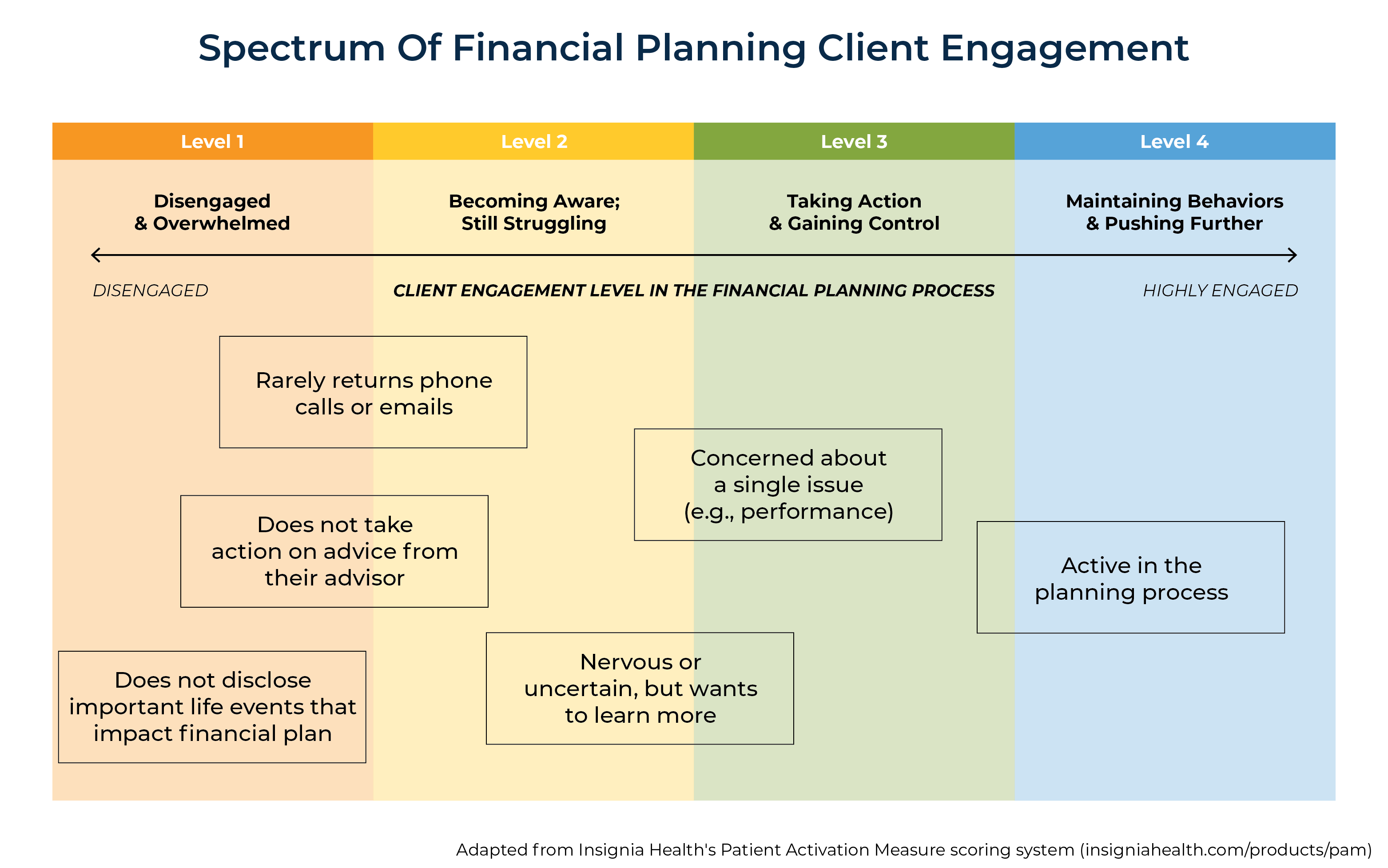
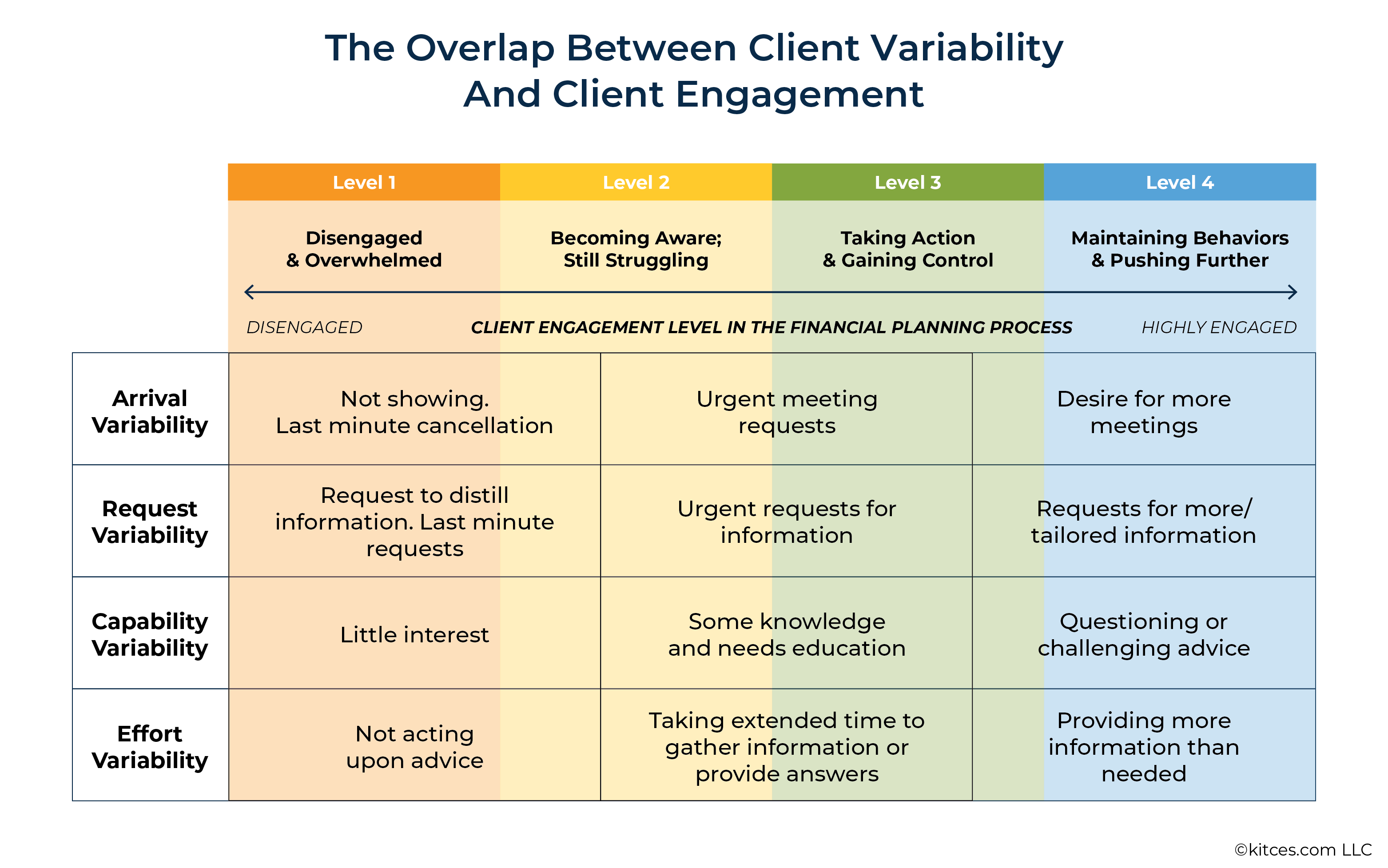
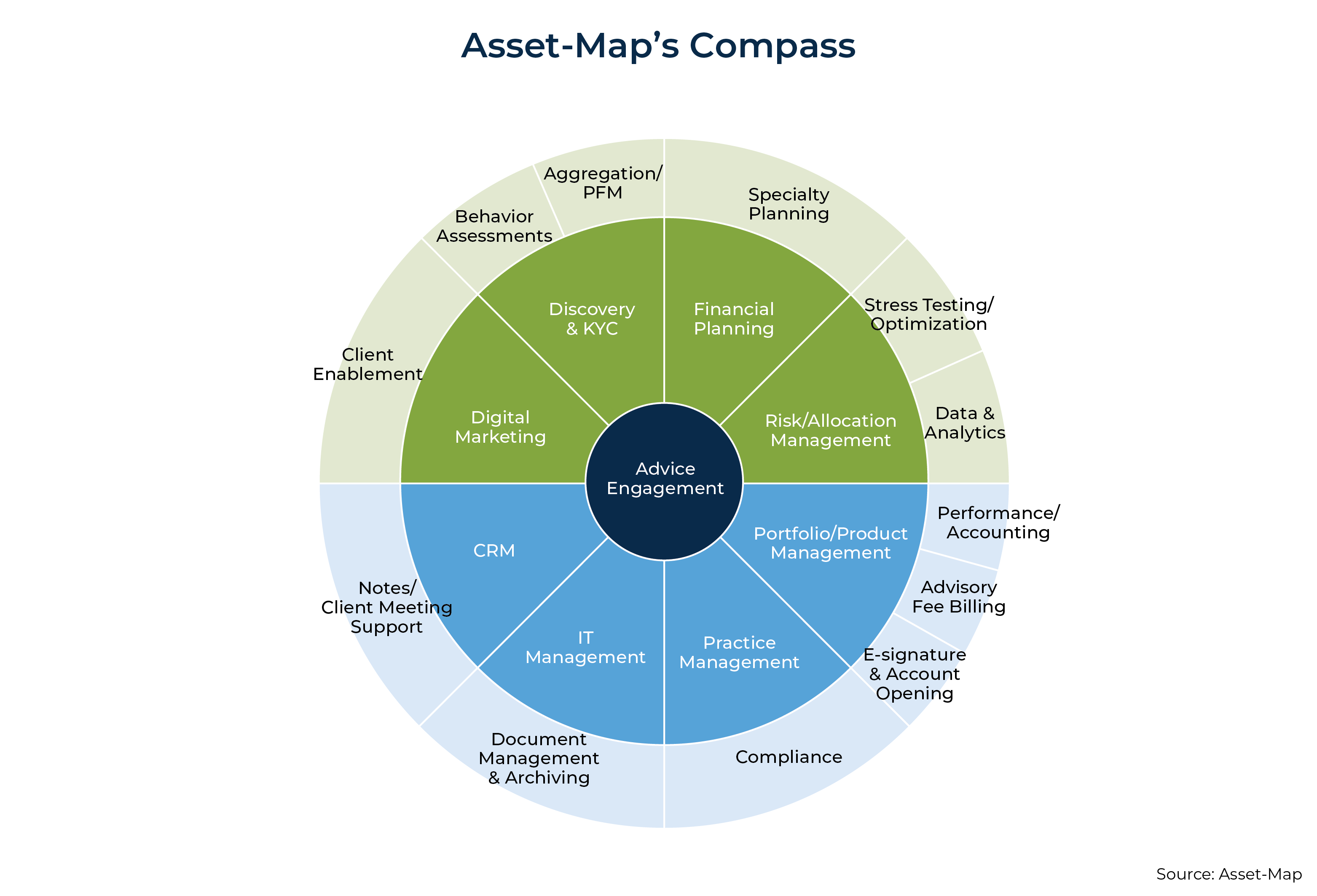
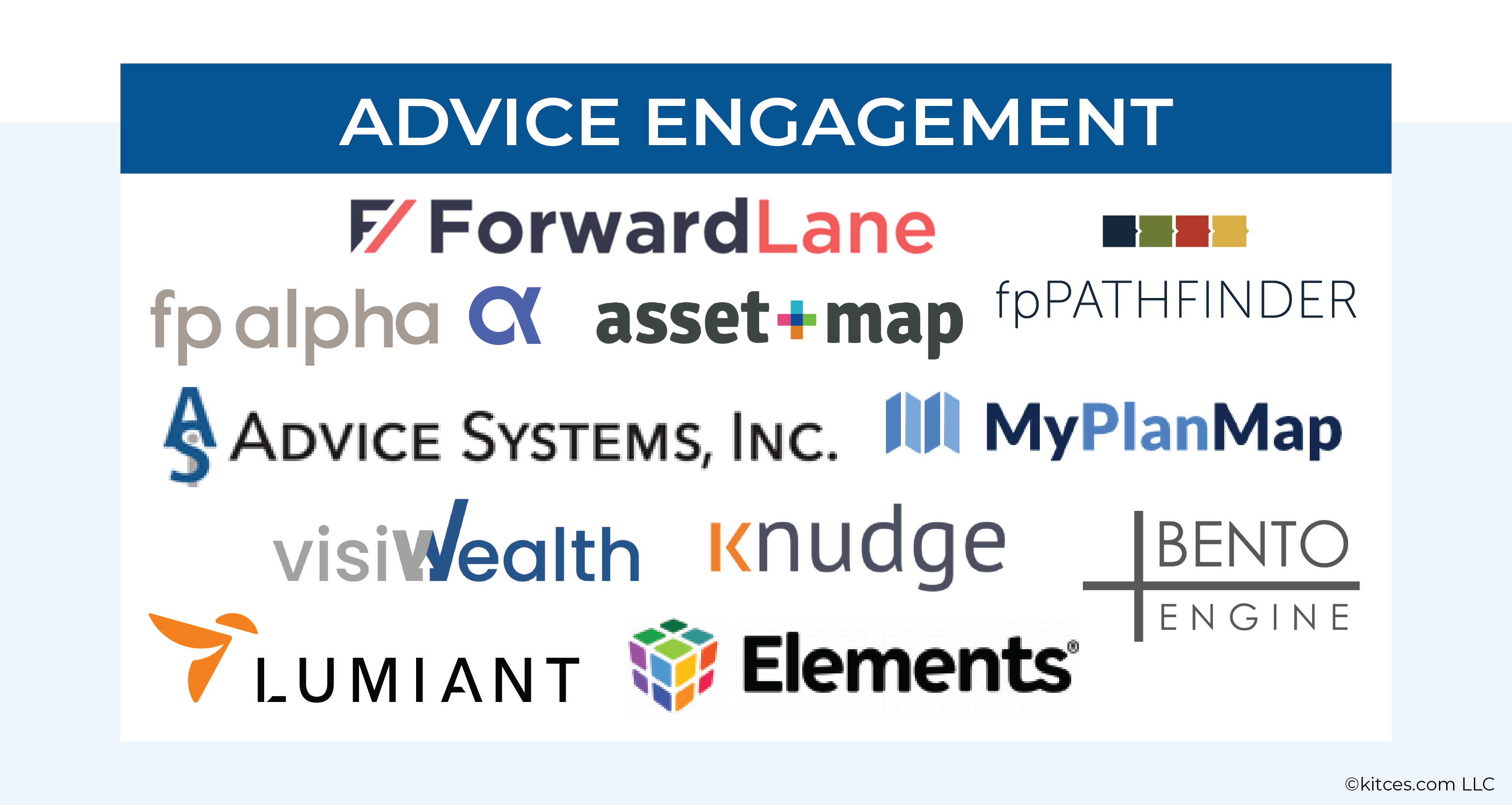
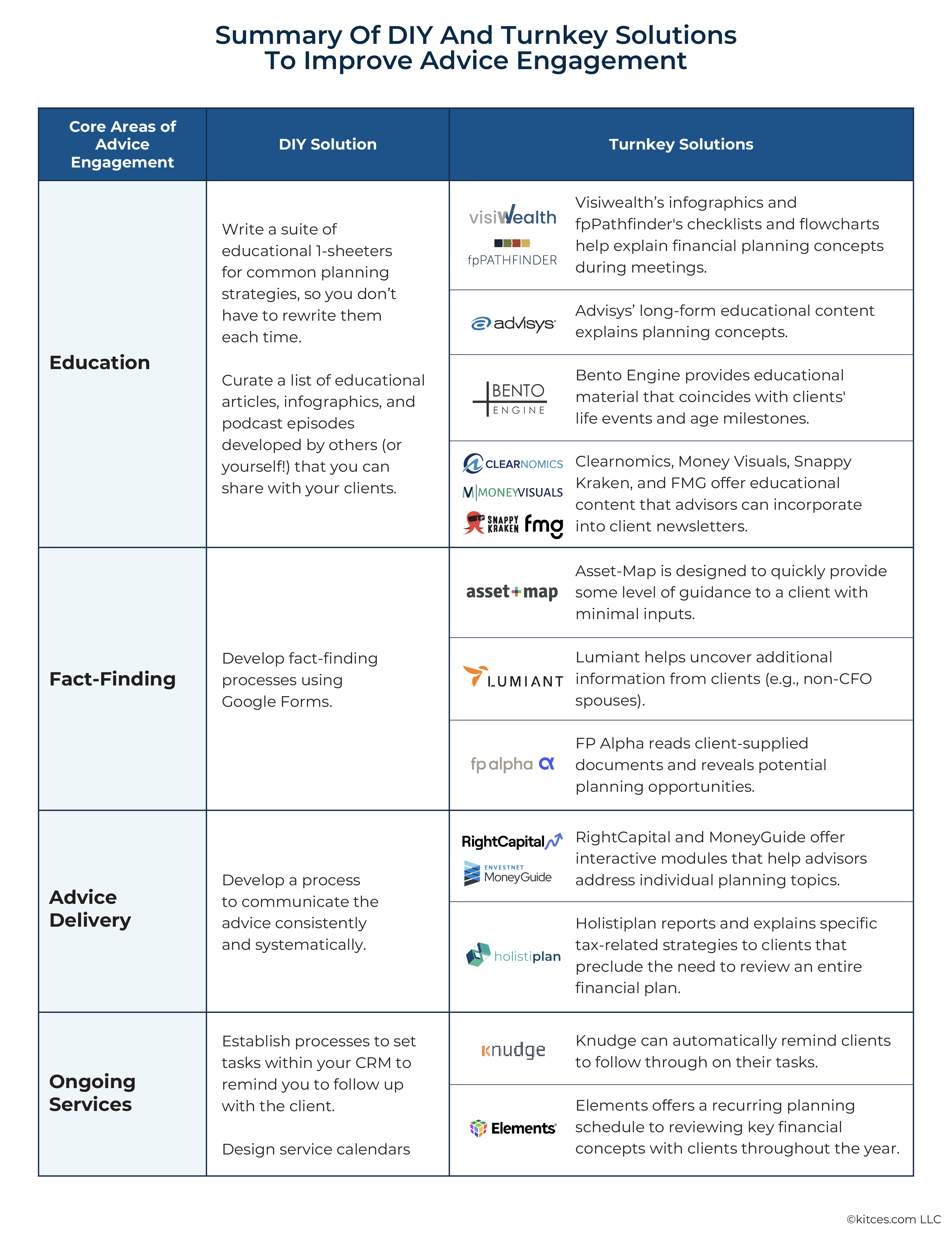



Leave a Reply